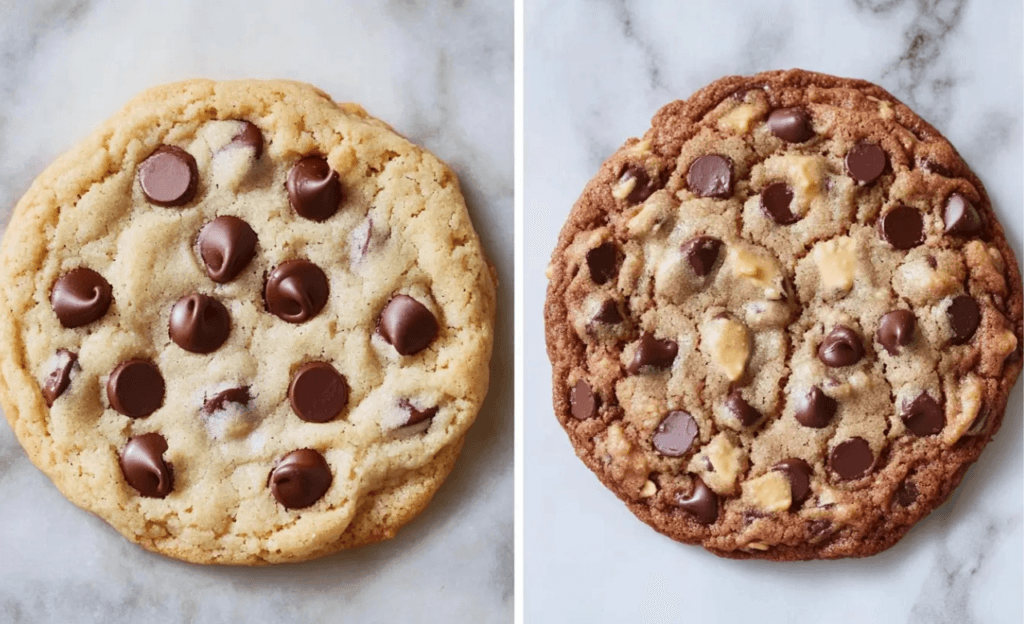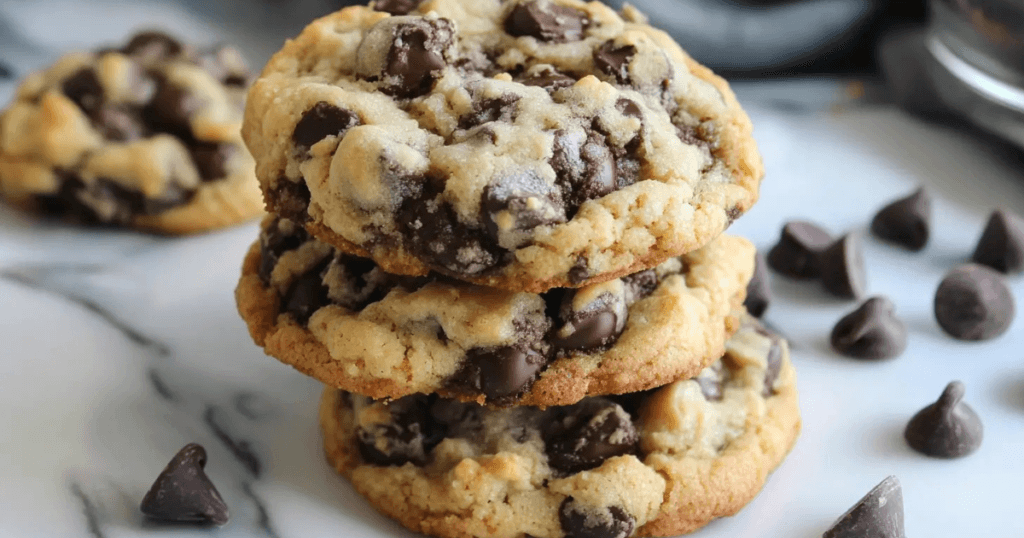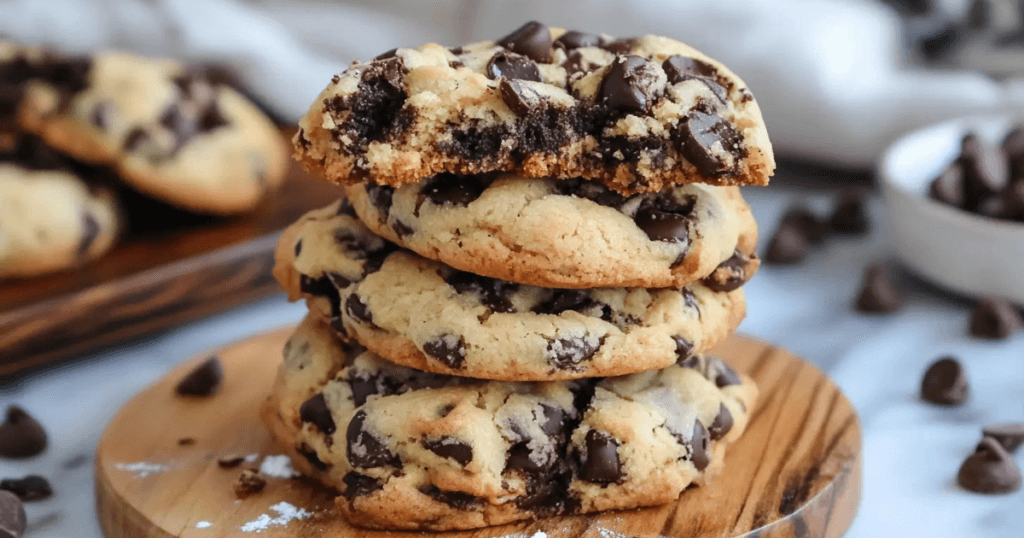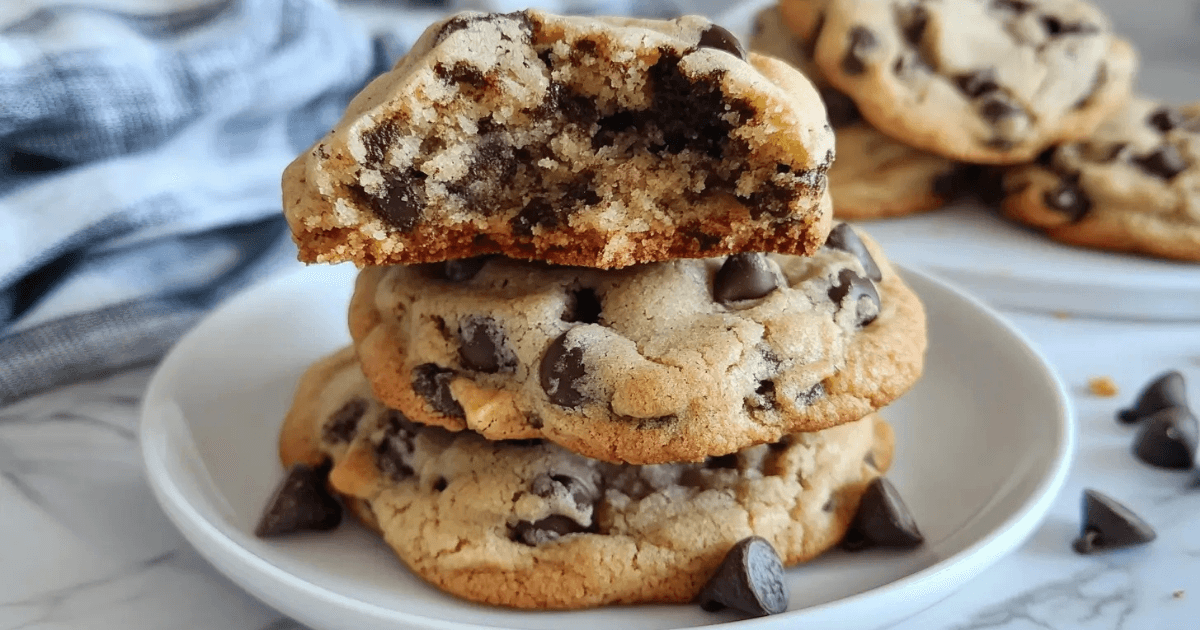Baking chocolate chip cookies should be a treat, but if you’ve ever wondered, “Why do my chocolate chip cookies taste like cake?”, you’re not alone. Trust me, I’ve been there—disappointed by cookies that were supposed to be chewy or crispy but turned out fluffy and soft instead.
In this article, we’ll Innovate the common reasons behind this baking mishap, from ingredient choices to mixing methods, and I’ll share tips to help you fix it. By the end, you’ll know exactly how to prevent your cookies from tasting like cake and bake the chewy or crispy cookies of your dreams.
Delicious recipes, check out our Cherry Chocolate Chip Cookies.
Table of contents
Common Reasons for Cakey Chocolate Chip Cookies
Excessive Leavening Agents: Why Cookies Turn Out Like Cake
If your cookies are puffing up like little cakes, baking powder or baking soda might be the culprits. These leavening agents are essential for helping your cookies rise, but too much can create unwanted fluffiness.
- Role of Baking Powder and Baking Soda in Cookie Texture
Baking powder and soda release carbon dioxide gas when they’re heated. This helps dough rise, which is great—if you’re baking a cake. For cookies, though, too much gas means too much lift, resulting in a texture that’s soft and airy instead of dense and chewy. - Impact of Overuse Leading to Cakey Consistency
Accidentally doubling the amount of leavening agent (we’ve all misread a recipe, right?) or using a formula with excessive leaveners can throw off your cookie game. A little goes a long way here! Stick to the recipe’s measurements, and consider reducing leaveners slightly if you like your cookies flatter and chewier.
Incorrect Flour Type or Measurement in Cookie Dough
Did you know that the type of flour you use and how you measure it can dramatically change your cookies’ texture?

- Differences Between All-Purpose Flour and Cake Flour
Cake flour has less protein than all-purpose flour, which means less gluten development. This leads to softer, more tender cookies. If your recipe calls for all-purpose flour and you substitute cake flour, your cookies might come out too soft and cakey. - Effects of Using Too Much Flour on Cookie Texture
Using too much flour is another sneaky culprit. When you scoop flour directly from the bag, you might accidentally pack in more than the recipe calls for. Extra flour absorbs more liquid, making the dough stiffer and leading to puffier cookies. Pro tip: use a spoon to fill your measuring cup and level it off with a knife for accurate results.
High Egg Content: A Cause of Cakey Cookies
Eggs are the glue that holds your dough together, but they can also make your cookies too fluffy if used in excess.
- Function of Eggs in Baking
Eggs add moisture and structure, which is great for baked goods. However, they also contribute to rise because of the water and proteins they contain. When heated, eggs firm up, giving baked goods their shape. - How Extra Eggs Can Result in a Cake-Like Texture
Adding an extra egg (or using large eggs when the recipe calls for medium) introduces more liquid and protein into your dough. This increases the rise and creates that dreaded cake-like texture. Stick to the egg count specified in your recipe to avoid this mistake.
Techniques to Prevent Cakey Cookies
Accurate Measurement of Ingredients
If you’re wondering, “Why do my chocolate chip cookies taste like cake?”, it might come down to something as simple as how you measure your ingredients. Trust me, this step matters more than you think!
- Importance of Using Proper Measuring Tools
Scooping flour straight from the bag? That’s a rookie move. It’s easy to pack in too much, which leads to a dense dough that bakes up like cake. Instead, use a spoon to fill your measuring cup and level it off with a knife. For even better results, invest in a kitchen scale for precise measurements—it’s a game-changer. - Tips for Measuring Flour and Sugars Correctly
Did you know sugar impacts texture, too? Using too much brown sugar adds moisture, while too much white sugar can lead to overly crispy cookies. Always measure sugars with the same care as flour—lightly scoop and level.
Adjusting Leavening Agents to Avoid Cakey Texture

Baking powder and baking soda can make or break your cookie texture. Too much, and you’re back to asking yourself, “Why do my chocolate chip cookies taste like cake?”
- Determining the Right Amount of Baking Soda and Baking Powder
A good rule of thumb is to use about 1/4 teaspoon of baking soda per cup of flour for cookies. If a recipe calls for both baking soda and powder, include the proportions are balanced to avoid excess lift. When in doubt, reduce the amount slightly—you can always experiment with the next batch. - Substituting Leavening Agents to Achieve Desired Texture
Want flatter, chewier cookies? Skip the baking powder entirely and rely on baking soda alone. The soda helps with spreading while giving just enough lift for that perfect balance.
Modifying Mixing Methods for Perfect Chocolate Chip Cookies
How you mix your dough plays a big role in its final texture.
- Avoiding Overmixing to Prevent Incorporation of Excess Air
Overmixing is a common mistake that traps air in the dough. More air means more rise, which means cakier cookies. Mix just until the ingredients come together—no more, no less. - Proper Creaming Techniques for Butter and Sugar
The creaming step can also introduce air if you’re too enthusiastic. Cream butter and sugar until they’re light and fluffy, but don’t go overboard. You want just enough aeration for soft but not overly puffy cookies.
Sugar Variations: Fixing Cakey Chocolate Chip Cookies

Sugar does more than just sweeten your cookies—it also influences moisture and texture.
- Using Brown Sugar vs. White Sugar for Chewier Cookies
Brown sugar contains molasses, which adds moisture and creates that rich, chewy texture we all love. If your cookies are tasting like cake, try increasing the ratio of brown sugar to white sugar. A 2:1 ratio of brown to white sugar often works wonders. - Impact of Sugar Ratios on Moisture and Texture
Too much white sugar can dry out your cookies, while too much brown sugar can make them overly moist and soft. Finding the right balance is key to avoiding a cake-like consistency.
Fat Choices to Prevent Cookies from Tasting Like Cake
The type of fat you use can completely transform your cookies.
- Butter vs. Shortening: How Fat Type Influences Cookie Consistency
Butter adds flavor and helps cookies spread, while shortening creates a more stable dough that tends to puff up rather than flatten. If your cookies are coming out too puffy, switch to all butter for better spread. - Incorporating Melted vs. Softened Butter for Different Results
Melted butter makes the dough thinner, resulting in flatter, chewier cookies. On the other hand, softened butter traps air when creamed, which can lead to a fluffier, more cake-like texture. Choose melted butter if you’re aiming for a chewy, dense cookie.
Frequently Asked Questions (FAQs)
Why Do My Chocolate Chip Cookies Taste Like Cake?
If you’ve ever baked a batch and thought, “Why do my chocolate chip cookies taste like cake?”, you’re not alone. This common issue often arises from using too much baking powder or baking soda, which causes excessive rising. Additionally, over-measuring flour or adding extra eggs can lead to a cakey texture. To achieve chewier cookies, include precise measurements and consider reducing leavening agents.
How Can I Make My Cookies Chewier Instead of Cakey?
To transform cakey cookies into chewy delights, adjust your ingredient ratios. Use more brown sugar than white sugar, as brown sugar adds moisture. Opt for melted butter instead of softened to increase chewiness. Also, slightly underbaking your cookies can result in a chewier texture.
Does the Type of Sugar Affect Cookie Texture?
Absolutely! The type of sugar significantly impacts cookie texture. Brown sugar contains molasses, adding moisture and creating a softer, chewier cookie. In contrast, white sugar leads to a crisper texture. Balancing the two can help you achieve your desired consistency.
Can Overbaking Cause Cookies to Become Cakey?
Overbaking typically results in dry, hard cookies rather than cakey ones. However, if your dough has too much leavening agent or flour, overbaking can exacerbate a cakey texture. It’s crucial to monitor baking time and ingredient proportions to get the perfect cookie.
What Role Does Butter Play in Cookie Consistency?
Butter is vital in determining cookie texture. Melted butter leads to denser, chewier cookies, while softened butter, when creamed with sugar, incorporates air, resulting in a lighter, potentially cakier texture. Choosing the right butter preparation is key to achieving your preferred cookie consistency.
Conclusion
If you’ve ever baked cookies and found yourself asking, “Why do my chocolate chip cookies taste like cake?”, don’t worry—you’re not alone. This common baking dilemma usually comes down to a few simple missteps in ingredient proportions, mixing methods, or baking techniques. Luckily, these issues are easy to fix with a little know-how.
Recap of Key Factors: Why Cookies Taste Like Cake
First, let’s revisit some of the usual culprits. Using too much baking soda or baking powder can cause your cookies to rise more than they should, giving them a fluffy, cake-like texture. Similarly, over-measuring flour can make your dough too dense, while using extra eggs adds more moisture and protein, leading to a softer and puffier result.
On the other hand, sugar and fat play equally crucial roles. For instance, brown sugar makes cookies chewier thanks to its molasses content, while white sugar creates a crisper texture. Meanwhile, melted butter promotes a denser cookie, whereas softened butter, when creamed, incorporates air and makes cookies fluffier. Each of these ingredients works together, so even small tweaks can change the final product.
Tips for Experimentation with Cookie Texture
If you’re determined to fix the issue, start by experimenting with ingredient ratios. Love chewy cookies? Use a higher ratio of brown sugar to white sugar. Want flatter cookies? Reduce or eliminate the baking powder and rely on baking soda alone.
Mixing techniques matter, too. Be careful not to overmix your dough—it might seem like a minor detail, but overmixing traps excess air, which contributes to that cakey texture. Similarly, avoid over-creaming your butter and sugar; cream just until combined for the best results.
Baking Techniques Matter for Cakey Cookies
Once your dough is ready, baking time and temperature are just as critical. Underbaking your cookies slightly (by about 1–2 minutes) can keep them chewy in the center while preventing them from puffing up too much. Lowering the oven temperature by 10–15°F can also help cookies spread more evenly, resulting in a denser texture.
Customize Your Chocolate Chip Cookies
Baking isn’t one-size-fits-all. Some people prefer a soft, pillowy cookie, while others crave the crisp edges of a bakery-style treat. If you’re somewhere in the middle, experiment with different ingredient swaps and baking techniques until you find the perfect balance. Remember, it might take a few batches to get it right—but hey, that’s just more cookies for you to enjoy!
Encouragement for Future Bakes
Ultimately, fixing the “cakey cookie” problem is all about understanding the science behind your ingredients and how they interact. The next time you wonder, “Why do my chocolate chip cookies taste like cake?”, you’ll have all the tools you need to make adjustments. And who knows? You might even discover your own signature cookie recipe along the way.
For even more tasty inspiration, check out our Ultimate Chewy Chocolate Chip Cookie Recipe. Happy baking!

